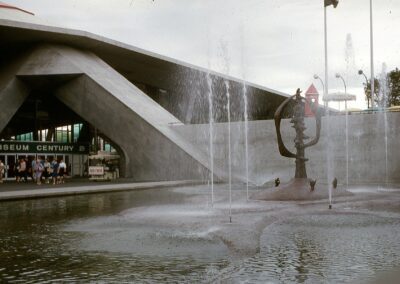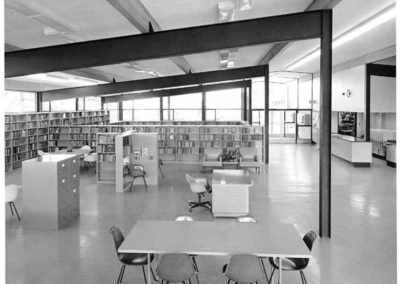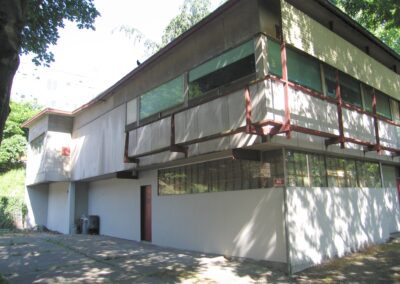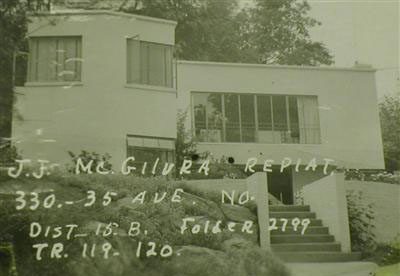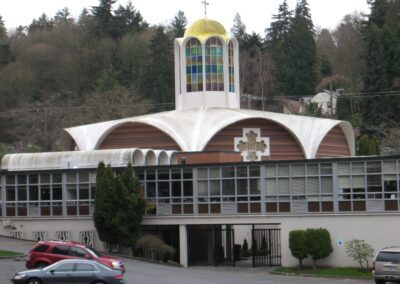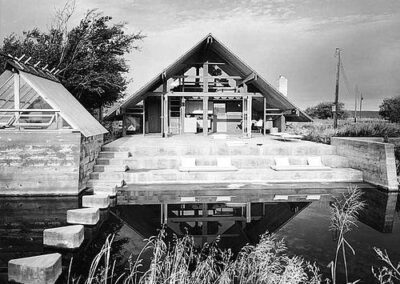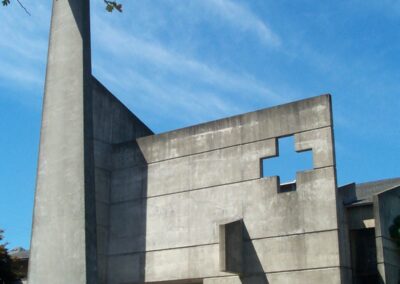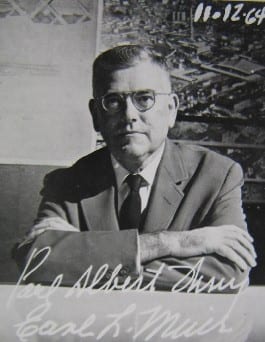
Thiry, Paul A.
Born in Nome, Alaska in 1904, Paul Albert Thiry designed a wide variety of buildings during his lengthy career and is credited by many with introducing European Modernism to Seattle and the Northwest. Thiry began his education at Saint Martin’s in Lacey and entered the University of Washington originally to study medicine. Mid-stream, he changed his major to architecture and graduated in 1928. Thiry also took a three-month summer course at the Ecole des Beaux Arts in Fountainbleau, which greatly affected his later designs. Upon returning to Seattle, he worked in the offices of Butler Sturtevant, John Graham, and Henry Bittman before opening his own practice in 1929.
At the beginning of his career Thiry focused on residential work. His early designs, such as the Lakecrest/Lake Court Apartments (Seattle, 1929) and St. Edwards Catholic Church (Shelton, 1931) referenced historic styles, including French Norman, Art Deco, and Colonial revival forms. In the early 1930s, with commissions dwindling due to the Depression, Thiry took a yearlong trip to Europe, Japan, India, China, Egypt, and Central America. During this travels, he was exposed to the work of European Modernists, and he met both Le Corbusier and Antonin Raymond.
The trip abroad significantly influenced Thiry’s work. Upon his return to Seattle, he opened a partnership with Alban A. Shay (1935-1940), and together they began designing some of the earliest works in the modern vein in the state. Among their project was Thiry’s own home (1936), the Nichols House (1939), and the Frank Barrett House (1937). At the time, the dwellings were a radical advancement for architecture in the Northwest. Thiry and Shay also designed the Chancery building (1939) in Seattle’s First Hill, built for the Catholic Diocese of Seattle as its home and administrative center.
During World War II, Thiry partnered with a number of other architects to produce large-scale public planning, housing, and military projects. His work during this period included design of the University of Washington’s West Kiln Building (1942) and collaboration on the Holly Park Housing Complex (1943). After the war, Thiry’s career turned to civic, institutional, and religious structures. He designed his own architectural office (1946) on Seattle’s First Hill (8th Ave and Columbia St, demolished) and occupied the building throughout his career. Projects in the post-war years include the Museum of History and Industry (1950), the Frye Art Museum (1952), Pi Mu Sorority (1952) at the University of Washington, and the Church of Christ the King (1952) in the Greenwood area.
During the 1950s, Thiry became active in civic affairs. He served as president of the Washington State American Institute of Architects in 1954, and was an influential member of the Executive Committee of the Puget Sound Regional Planning Council from 1954 to 1957, and the City of Seattle’s Planning Commission from 1952 to 1961.
It was during this period in his career that Thiry’s work began to be widely published. Publications including spreads in Sunset, The Modern House in America, Architectural Record, Architectural Forum, Pencil Points, and other home building magazines. Among his more noteworthy projects was the Northeast Branch Library (1954) in Seattle. Thiry’s design was recognized immediately by local and national publications and received a Seattle AIA Honor Award in 1955.
Thiry’s career continued to flourish for several decades and he received many high profile projects. Among them was the Washington State Library (1959) in Olympia, the U.S. Embassy Residence (1961) in Santiago, Chile, the Watzek Library (1968) at Lewis and Clark College in Portland, and Christ Episcopal Church (1969) Tacoma.
Other projects from this era included the Covenant Chapel (1956) in Seattle, Regents Hall (1956) at Washington State University, Higgins Hall (1959), Haggard Science Hall (1958), and the Viking Commons Dining Facility at Western Washington University, the Mercer Island Presbyterian Church (1961), St. Demetrios Greek Orthodox Church (1962) in the Montlake neighborhood, and the Delta Upsilon Fraternity (1966) at the University of Washington.
Thiry also designed many larger homes such as the Francis Brownell Jr. Residence (1962) at The Highlands, the Thomas Stimson House (1952), and the Allison Wanamaker House (1957) in Seattle.
Greater local recognition of Paul Thiry’s design came with his work for the Seattle World’s Fair. In 1958, while the plans for this Exposition were in a seminal stage, he was appointed as its primary planner and architect. The Century 21 Exposition grounds/Seattle Center represents Thiry’s Modern concepts of city planning and architectural design, primarily through site planning and his design of both temporary and permanent structures. At the fair Thiry designed the First National Bank Pavilion, State of Washington Theme Building, the Nalley Theater and Exhibition Building, and the Seattle Center Coliseum.
Thiry’s buildings and the influence of his planning and architectural ideas were recognized in local and national publications. Both the Chamber of Commerce and the City Council honored him as “Man of the Year” in 1962. Likewise, he was elected to the AIA’s College of Fellows that same year. He was appointed to the National Capitol Planning Commission by President Kennedy in 1963, and to the Kennedy Library Commission by Jacqueline Kennedy in 1964. His later designs included the Agnes Flanagan Chapel at Lewis and Clark College (Portland, 1972).
Thiry died in 1993 at the age of 89. He was known throughout his career as a leader in twentieth century Northwest architecture. His five decades of practice resulted in a lasting legacy of local, national, and international projects.
Download PDF document to see a list of known Thiry projects. Download PDF (1.6M) »
